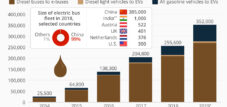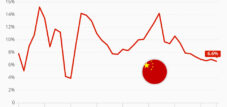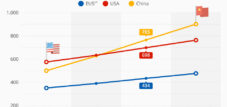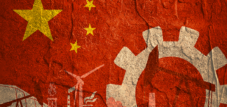China's military parade: Weapons designed to impress – What did China show at its grand 2025 military parade?
Xpert pre-release
Language selection 📢
Published on: September 3, 2025 / Updated on: September 3, 2025 – Author: Konrad Wolfenstein

China's military parade: Weapons designed to impress – What did China show at its grand 2025 military parade? – Image: Xpert.Digital
China's show of power: Why experts warn of a new arms race after the parade
### Hypersonic missiles & underwater drones: These superweapons were showcased by China at its mega-parade ### "Virtually impossible to intercept": How dangerous are China's new missiles really? ### Nuclear weapons, lasers, AI jets: China's military reveals its plans – and its weaknesses ###
More than just a show: What China's military parade means for Taiwan and global security
On September 3, 2025, the world held its breath as China staged one of the largest military parades in its history in Beijing's Tiananmen Square. The occasion was the 80th anniversary of the end of World War II, but the message was unmistakably future-oriented. Before the eyes of Russian President Vladimir Putin and North Korean leader Kim Jong Un—an unprecedented encounter demonstrating a new "axis of autocracies"—President Xi Jinping presented an army that emphatically underscored its claim to global superpower status. The parade was a perfectly orchestrated propaganda spectacle designed not only to demonstrate strength but also to deliberately intimidate the West.
At the heart of the show of force was an arsenal of state-of-the-art weapons systems that threatens to shift the global strategic balance. From hypersonic missiles like the DF-17 and DF-27, which render existing defense systems virtually ineffective, to massive, nuclear-powered underwater drones, mobile laser weapons, and unmanned "Loyal Wingman" fighter jets, China unveiled technological leaps that are raising alarm bells for NATO and its allies. At the same time, Beijing is expanding its nuclear arsenal at a pace that is definitively abandoning the previous doctrine of minimal deterrence and ushering in a dangerous trilateral arms race with the US and Russia.
This article provides a detailed analysis of the weapons systems and their military capabilities displayed at the parade. It sheds light on the strategic goals China is pursuing with its rapid modernization and examines the reactions of its worried neighbors in the Pacific region, from Taiwan to Japan. It also discusses how NATO and Europe assess the growing threat, Germany's critical dependencies—for example, in ammunition production—and the structural weaknesses China's military continues to exhibit despite its impressive facade. Ultimately, the question arises: What does China's rise mean for the global security architecture, and how must the West respond to this new reality?
Xi, Putin and Kim united: This picture of the military parade is a direct warning to the West
On September 3, 2025, China staged one of the largest military parades in its history to mark the 80th anniversary of the end of World War II. Over 10,000 soldiers marched in Beijing's Tiananmen Square, while state-of-the-art weapons systems were showcased. The parade was not only a display of military might, but also a carefully orchestrated propaganda spectacle. Security measures were so strict that local residents were even forbidden from cooking on the morning of the parade to keep the skies above the capital clear of smoke. Instead, they received breakfast packages of hard-boiled eggs and pickles.
The parade took place in front of prominent guests, including Russian President Vladimir Putin and North Korean leader Kim Jong Un. It was the first time the three heads of state, Xi Jinping, Putin, and Kim, appeared together in public. This unprecedented demonstration of the Chinese-Russian-North Korean alliance sent a clear signal to the West.
Which new weapon systems were presented?
New generation hypersonic missiles
China showcased an impressive array of hypersonic missiles that pose a serious challenge to Western defense systems. The YJ-17 hypersonic anti-ship missiles can be launched from bombers beyond enemy air defenses and penetrate virtually any known defense. These missiles reach speeds exceeding Mach 5 and are extremely difficult to intercept due to their maneuverability in flight.
Particularly threatening is the DF-17, which has been in service with the Chinese military since 2020. This ballistic missile is distinguished by its ability to support a hypersonic flight maneuver during the mid- and terminal flight phases, making interception by existing missile defense systems such as THAAD, SM3, and Patriot virtually impossible. With a range of 1,500 kilometers for the missile itself and another 1,000 kilometers for the detached glider, the entire system achieves a maximum range of 2,500 kilometers.
The even more advanced DF-27, which may have entered service before 2019, has a range of 5,000 to 8,000 kilometers, allowing it to strike Hawaii from the Chinese coast. This missile is designed to carry multiple warhead types and attack multiple targets simultaneously.
Underwater drones as a new threat
One of the most spectacular new introductions were torpedo-shaped underwater drones rolled across the Aisle of Eternal Peace on trucks. These colossal-looking systems, possibly the AJX002 with a length of approximately 20 meters, could be used as stealth submarines. Experts suspect that these drones are modeled after the Russian Poseidon torpedo and could be powered by a tiny nuclear reactor, which would give them a virtually unlimited range.
These autonomous underwater vehicles could theoretically patrol the world's oceans undetected for months and strike on command, opening up a completely new dimension of naval warfare.
Revolutionary laser weapons
China unveiled the LY-1 mobile laser weapon, a high-energy laser system capable of intercepting swarms of small drones or guided missiles. This vehicle-mounted system represents a significant development in air defense and could be particularly effective against the increasingly used drone swarms in modern conflicts.
Unmanned fighter jets and Loyal Wingman systems
The unmanned fighter jets and the so-called Loyal Wingman drones attracted particular attention. These systems can support crewed fighter jets such as the J-20 stealth fighter or fly independent reconnaissance missions. The J-20, China's first self-developed stealth fighter, has also been available in a two-seat version specifically designed to command drone swarms since 2021.
The FH-97A, a supersonic combat drone, is said to be capable of matching the performance of the J-20 stealth fighter, potentially giving China a leg up on its competitors. These Collaborative Combat Aircraft are being hailed by experts as the future of air warfare.
How threatening is China's nuclear arsenal really?
Massive expansion of nuclear weapons
China's nuclear arsenal has expanded dramatically in recent years. According to the Stockholm International Peace Research Institute, the arsenal has been growing by about 100 warheads annually since 2023 and now stands at at least 600. By 2035, the number could rise to 1,500, meaning China will abandon its previous strategy of minimal nuclear deterrence.
The country is currently building approximately 350 new silos for intercontinental ballistic missiles in desert and mountainous regions. Fully equipped silos would allow China to deploy over 1,200 warheads on ICBMs alone, many with multiple independently controlled reentry vehicles. These figures illustrate the extent of China's nuclear buildup.
New carrier systems
In addition to the sheer number of warheads, China is also modernizing its delivery systems. New submarines such as the 096 type and H-20 strategic bombers are being developed. The Dongfeng intercontinental ballistic missiles displayed at the parade, which can reach Europe or the US mainland, have been part of China's inventory for some time.
Some nuclear weapons, previously stored separately from their missiles, are now likely ready for immediate deployment, significantly reducing response time. This development marks a clear shift from a defensive to a more offensive nuclear strategy.
How are China's neighbors reacting to the military buildup?
Growing tensions in the Pacific region
China's military modernization and aggressive rhetoric are increasingly putting pressure on its neighboring countries in the Pacific region. The People's Republic claims almost the entire South China Sea for itself and regularly conducts military exercises around Taiwan. These activities have led to a spiral of arms buildup in the region.
Taiwan sees itself as particularly threatened and is intensively preparing for a possible Chinese attack. The country has expanded its annual Han Kuang 2025 military exercise from five to ten days and mobilized 22,000 reservists. For the first time, civilians will also be included in the exercises to test the resilience of cities and communities.
Philippines and other ASEAN countries under pressure
The Philippine Navy and Coast Guard are increasingly under military pressure from China. The People's Republic is asserting its claims in the South China Sea with increasingly aggressive coast guard and naval vessels. This development has prompted the United States to increase its military support for the Philippines.
Other states in the region, such as Vietnam, Malaysia, and Brunei, also lay claim to parts of the South China Sea, but feel intimidated by China's aggressive stance. The more these countries feel pressured by Beijing, the more they orient themselves toward Washington and intensify their cooperation with the United States.
Japan is arming itself
Japan views China as a direct threat in the region and has accelerated its military buildup in recent years. The country is preparing to develop long-range missile strike capabilities and is reinterpreting its pacifist postwar constitution to allow for military engagement abroad.
Postwar pacifism is increasingly being sacrificed for a more robust defense policy, and the defense budget is continuously growing. This development is a direct response to China's maritime assertiveness in the East China Sea and concerns about a potential blockade of Taiwan.
Hub for security and defense - advice and information
The hub for security and defense offers well-founded advice and current information in order to effectively support companies and organizations in strengthening their role in European security and defense policy. In close connection to the SME Connect working group, he promotes small and medium -sized companies (SMEs) in particular that want to further expand their innovative strength and competitiveness in the field of defense. As a central point of contact, the hub creates a decisive bridge between SME and European defense strategy.
Suitable for:
Hypersonics and drone swarms: How the West must rethink its defense
What weaknesses does China's military have despite modernization?
Lack of combat experience
Despite its impressive weapons systems and numerical superiority, China's military has significant weaknesses. One major problem is its lack of combat experience. The People's Liberation Army has not conducted any major military operations since the brief border war with Vietnam in 1979. This lack of practical experience in modern conflicts is a significant disadvantage compared to armies like the American one, which boast decades of combat experience.
Xi Jinping's distrust of the generals
Another structural problem is Xi Jinping's apparent distrust of his own generals. The Chinese president has dismissed or demoted several high-ranking military leaders in recent years for alleged corruption. This climate of mistrust can significantly impair the efficiency and morale of the armed forces.
Corruption in the military
Corruption remains a persistent problem in the Chinese military. Despite Xi Jinping's anti-corruption campaign, cases of bribery and nepotism have repeatedly come to light, potentially undermining the troops' combat readiness and professionalism.
Logistical challenges
An invasion of Taiwan would require China to conduct one of the most complex amphibious operations in military history. The logistical challenges of such an operation are immense, and it is questionable whether the Chinese military has the necessary experience and equipment to successfully accomplish such a task.
How do NATO and Europe assess China's military threat?
NATO concerns about Chinese-Russian cooperation
NATO views the growing military cooperation between China and Russia with great concern. NATO Secretary General Mark Rutte warned of a coordinated scenario in which China could attack Taiwan while simultaneously encouraging Russia to keep NATO militarily busy in Europe. This fear is based on the close partnership between Xi Jinping and Putin, who have already met face-to-face 40 times.
NATO accuses China of playing a crucial role in Russia's war of aggression in Ukraine. According to the alliance, China supplies both civilian and military goods to Moscow and supports the Russian defense industry. According to an analysis by the Center for European Policy Analysis, China has become a key enabler of Russia's war effort.
European reactions
Germany and other European countries are increasingly concerned about China's aggressive stance. German Foreign Minister Johann Wadephul sharply criticized China's behavior in the Pacific region and warned of the consequences for Europe. He emphasized that China's increasingly aggressive activities in the Taiwan Strait and the South and East China Seas also threaten fundamental principles of the global order.
Concerns are growing about an escalation in the Taiwan Strait conflict, as this area is considered a sensitive crossroads of global trade and could have serious consequences for global security and the economy. Germany has already signaled that Bundeswehr ships could potentially sail through the Taiwan Strait to demonstrate freedom of navigation in international waters.
Specific incidents
The tensions are also manifesting themselves in specific incidents. A German reconnaissance aircraft was attacked with a laser by a Chinese warship in the Red Sea in early July 2025. This incident illustrates how far China is willing to go to assert its interests, even if this endangers the safety of soldiers of allied nations.
What strategic goals does China pursue with its military modernization?
Vision of a world-class army by 2050
Xi Jinping has set the ambitious goal of building a world-class army by 2050, capable of waging war and successfully conducting operations anywhere in the world. This vision is part of a comprehensive strategy to make China a dominant global power. Mechanization is to be completed by 2020, modernization by 2035, and by 2050, the People's Liberation Army is to be among the world's leading armies.
Power projection beyond the first island chain
China seeks to extend its military reach far beyond the traditional boundaries of its immediate neighborhood. It intends to conquer the so-called first island chain, stretching from Japan through Taiwan to the Philippines, in order to gain direct access to the Pacific. This strategy aims to challenge American hegemony in the Pacific and establish its own spheres of influence.
Deterrence and intimidation
The military parade and the display of state-of-the-art weapons technology also serve as a form of psychological warfare. China aims to intimidate potential adversaries while simultaneously encouraging its own allies. The message is clear: China is willing and able to assert its interests with military force if necessary.
How dependent is Germany on China in defense matters?
Critical dependence on ammunition production
Germany is precariously dependent on China, especially in ammunition production. A critical raw material called linters, a byproduct of cotton production, is needed for every cartridge and bullet and comes almost exclusively from China. All European arms manufacturers rely on these Chinese supplies.
The Bundeswehr currently only has enough ammunition to last a few hours, or at most, days of intensive combat. This dramatic shortage is exacerbated by China's sluggish exports of the necessary raw materials. Experts see this as a deliberate attempt to sabotage Western defense capabilities in retaliation for its support of Ukraine.
Structural weaknesses of the Bundeswehr
The German armed forces are suffering from decades of underfunding and neglect. Despite the €100 billion special fund, the structural problems are so profound that a rapid improvement is unlikely. Defense companies have been scaling back their production for years because the Bundeswehr has barely purchased any ammunition.
Arms deliveries to Ukraine have also left gaps in Germany's defense capabilities. Main battle tanks, air defense systems, and self-propelled howitzers were withdrawn from active Bundeswehr units and have not been replaced to this day. Germany has no reserves of military equipment, which significantly limits its ability to act.
What does China's rise mean for the global security architecture?
Emergence of a multipolar world order
China's military modernization is part of a larger geopolitical shift toward a multipolar world order. The close cooperation between China, Russia, and North Korea, as demonstrated at the military parade, indicates the emergence of an anti-Western bloc. This axis of autocracies fundamentally challenges the US-dominated world order that has existed since 1945.
Arms race between three nuclear powers
The traditional bipolar nuclear arms race between the US and Russia is evolving into a dangerous triangular situation with China as a third player. This constellation poses significant risks for miscalculations and unintended escalations. Unlike during the Cold War, there are no established channels of communication or arms control agreements between all three parties today.
Challenge for international institutions
China's rise also poses significant challenges to existing international institutions and norms. The country is using its growing power to strengthen alternative structures such as the Shanghai Cooperation Organization and to undermine the Western-dominated liberal world order. This development could, in the long term, lead to a fragmentation of the international community.
What role does Taiwan play in China's military strategy?
Taiwan as a test case for Chinese ambitions
Taiwan occupies a central role in China's military-strategic considerations. Beijing views the democratic island as a renegade province that seeks to be reunified by military force if necessary. US Secretary of Defense Pete Hegseth warned that Xi Jinping has ordered his military to be ready to invade Taiwan by 2027.
Military preparations intensify
China regularly conducts large-scale military exercises around Taiwan, continually increasing the intensity and scale of these drills. In December 2024, China conducted its largest naval exercise in three decades, involving 90 ships, two-thirds of which were warships. These activities are interpreted as a dress rehearsal for a possible invasion.
Geopolitical significance beyond the region
A conflict over Taiwan would have far-reaching implications for global security and the economy. The Taiwan Strait is one of the world's most important shipping routes, and Taiwan is a key hub in global semiconductor supply chains. A military conflict would devastate not only the region but the entire global economy.
How effective are Western defense strategies against China's new weapons?
Challenges for existing defense systems
China's new hypersonic weapons pose significant challenges for Western defense systems. Due to their speed and maneuverability, the DF-17 and other hypersonic missiles are virtually uninterceptable by currently available systems such as THAAD, Patriot, or SM-3. These weapons could render existing missile defense concepts virtually ineffective.
Adaptation of NATO strategies
NATO must fundamentally rethink its defense strategies to respond to the new threats. NATO Secretary General Rutte emphasizes that the Alliance can only maintain its credibility through faster responses and increased armament efforts. Member states' defense spending must be significantly increased to keep pace with China's military buildup.
Technological race
The West is engaged in an intense technological race with China, particularly in areas such as artificial intelligence, quantum technology, and autonomous weapons systems. China's advances in drone swarms and loyal wingman systems demonstrate that the country may already be a technological leader in some areas. This development requires massive investments in research and development from Western nations.
The 2025 Chinese military parade marks a turning point in the global security architecture. As China demonstrates its military power and showcases new weapons technologies, NATO and Europe must fundamentally rethink their strategies. The challenge is how to respond to an emerging military power that is both technologically advanced and strategically ambitious. The question is no longer whether China poses a global military threat, but how the West will respond to this new reality.
Advice - planning - implementation
I would be happy to serve as your personal advisor.
Head of Business Development
Chairman SME Connect Defense Working Group
Advice - planning - implementation
I would be happy to serve as your personal advisor.
contact me under Wolfenstein ∂ Xpert.digital
call me under +49 89 674 804 (Munich)




















